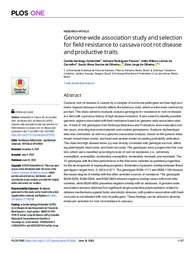Genome-wide association study and selection for field resistance to cassava root rot disease and productive traits.
Genome-wide association study and selection for field resistance to cassava root rot disease and productive traits.
Author(s): HOHENFELD, C. S.; PASSOS, A. R.; CARVALHO, H. W. L. de; OLIVEIRA, S. A. S. de; OLIVEIRA, E. J. de
Summary: Cassava root rot disease is caused by a complex of soil-borne pathogens and has high economic impacts because it directly affects the tuberous roots, which are the main commercial product. This study aimed to evaluate cassava genotypes for resistance to root rot disease in a field with a previous history of high disease incidence. It also aimed to identify possible genomic regions associated with field resistance based on genome-wide association studies. A total of 148 genotypes from Embrapa Mandioca and Fruticultura were evaluated over two years, including improved materials and curated germplasms. Analysis of phenotypic data was conducted, as well as a genomic association analysis, based on the general linear model, mixed linear model, and fixed and random model circulating probability unification. The observed high disease index (ω) was directly correlated with genotype survival, affecting plant height, shoot yield, and fresh root yield. The genotypes were grouped into five clusters, which were classified according to level of root rot resistance (i.e., extremely susceptible, susceptible, moderately susceptible, moderately resistant, and resistant). The 10 genotypes with the best performance in the field were selected as potential progenitors for the development of segregating progenies. Estimates of genomic kinship between these genotypes ranged from -0.183 to 0.671. The genotypes BGM-1171 and BGM-1190 showed the lowest degree of kinship with the other selected sources of resistance. The genotypes BGM-0209, BGM-0398, and BGM-0659 showed negative kinship values with most elite varieties, while BGM-0659 presented negative kinship with all landraces. A genome-wide association analysis detected five significant single nucleotide polymorphisms related to defense mechanisms against biotic and abiotic stresses, with putative association with fresh root yield in soil infested with root rot pathogens. These findings can be utilized to develop molecular selection for root rot resistance in cassava.
Publication year: 2022
Types of publication: Journal article
Keywords: Cassava, Doença de Planta, Mandioca, Pathogens, Patógeno, Plant pathogens, Podridão Radicular, Raiz, Root diseases
Observation
Some of Embrapa's publications are published as ePub files. To read them, use or download one of the following free software options to your computer or mobile device. Android: Google Play Books; IOS: iBooks; Windows and Linux: Calibre.
Access other publications
Access the Agricultural Research Database (BDPA) to consult Embrapa's full library collection and records.
Visit Embrapa Bookstore to purchase books and other publications sold by Embrapa.

